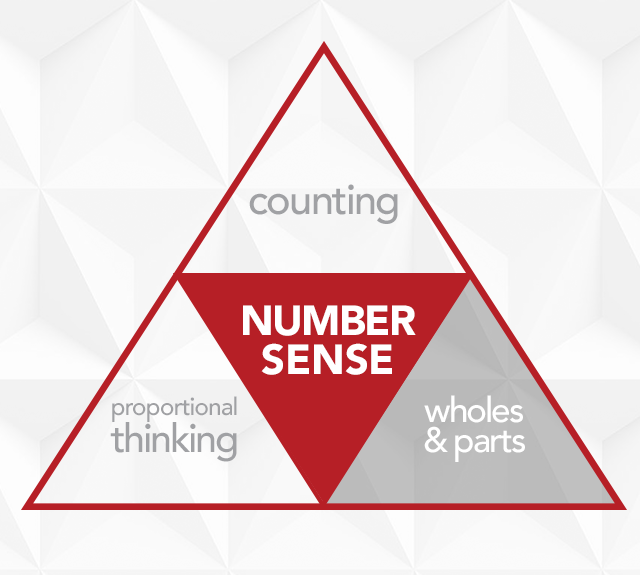Number Sense is the ability to appreciate the size and scale of numbers in the context of the question at hand. Three elements establish Number Sense: Counting, Wholes and Parts, and Proportional Thinking. We already introduced Counting in Part 1 of our Number Sense Series. Today, we will focus on Wholes and Parts.
The two aspects of the concept of Wholes and Parts form the backdrop for many mathematical concepts: fractions and complements.
First, let’s discuss fractions. For many people, when they hear the phrase “wholes and parts,” the first thing that comes to mind is “fractions.” This is also the first aspect of “wholes and parts” in the Mathnasium curriculum.
Many people do not have a clear idea of what a fraction represents: a whole that is broken into equal parts creates fractions. Children demonstrate an awareness of this idea from a very early age through the concept of sharing. Ask a young child to share a candy bar with you in a fair way and watch what they do; importantly, have them explain their thought process to you.
Children need to be introduced to the fraction “half” as being “2 parts the same.” Before other fractions are introduced (1/3s, 1/4s…) children need to master questions such as:
How much is half of 6? 3? 7? 20? ½? 99?
and…
Half of what number is 5? 10? 25?
100% of something represents a whole. Break down the word ‘percent’ for what it is: per-CENT— “for each 100.” This connection eliminates the need to get out a pencil and paper to compute 7% of 250, as the result is 7 + 7 (7 for each 100) + 3½ (half of 7 for the half of 100). The answer is 17½.
The second aspect of “wholes and parts” supported by Mathnasium curriculum is complements.
A complement is the amount needed to make a whole complete.
Remember the age-old expression:
“The whole equals the sum of its parts”
and the related statement that
“Any one part equals the whole minus the sum of the other the other part(s).”
This second statement is saying that “the whole is made up of complements.”

Let’s dig deeper into the concept of complements.
Strong problem-solving skills require the ability to identify the missing part(s)—the complement(s).
Children should be asked to visualize and answer a question like:
Together we have 10 pieces of candy. You have 7 pieces. How many pieces do I have? Here, the whole is 10 and one part is 7. So, the other part is 10 minus 7 (the whole minus the part you know). So, 3 is the complement.
This will help set up their understanding of complements.
When dealing with problem solving that involves Wholes and Parts, kids really like examples that deal with cookies, sandwiches, or anything they can eat. Try this example:
You have a box of cookies. You get to eat half of them after lunch and half of what is left over after dinner. After dinner, you have 3 cookies left. How many cookies did you start with? [The answer is 12.]
When a word problem is set up like this, children can often visualize the situation. If visualization doesn’t work, have a Plan B (drawing a picture), or C (using physical objects) until the child understands.
By learning to think in terms of Wholes and Parts, a child can develop a strong understanding of the structure of mathematics. Over time, knowledge of Wholes and Parts helps to build up a child’s foundational knowledge, so they can learn to solve complex fractions, equations, and a wide variety of word problems. Without a solid understanding of Wholes and Parts, solving many types of word problems becomes difficult—if not impossible—for many students.
For every child, there is a way to explain any topic in a way that makes sense to them.






